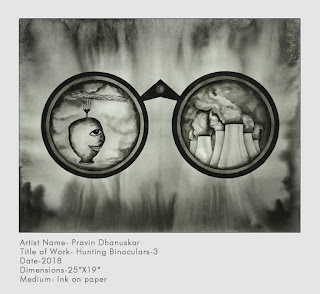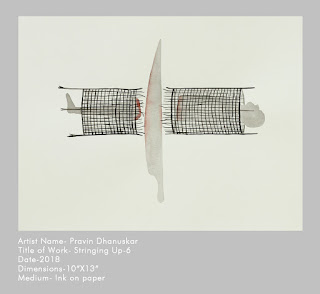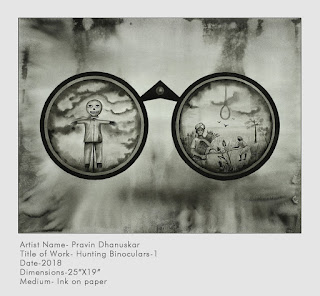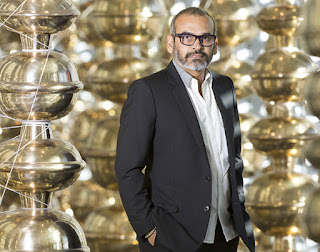(Artist Shashikant Dhotre)
Exquisitely painted images and charming
beauties from some dreamy lands, dimly lit surroundings contrasted by the
starkly lit models and their silk saris cascading and rippling, and the
absolute mystery enveloping the maker of all these images together imparts an
absolutely captivating aura to the paintings of Shashikant Dhotre. In the
social media his works, at times with acknowledgement and mostly without any
mention of the artist’s name, are a sensation often eking out comments of
excitement and wonder; the common man out there in the social media expresses
his fascination for Dhotre’s paintings mainly by underlining that fact they are
‘painted’ images. A painted image, at least in the eyes of a common man is
attractive and awe inspiring only when it surpasses the perfection of an image
captured in a photograph. This immediate comparison comes from the fact that a
photographic image is an image that concurs with the image caught in the human
eyes. Here human eyes become the ultimate judge of perfection and similitude
though they overlook the manipulations mechanically possible in the case of a
photographic image.
From the very beginning of modern art an
image produced by a camera has been the ultimate referential point of
paintings. How far an image created by an artist on a two dimensional surface
was similar to a possible photographic image captured in the given time, space
and light had become a touchstone for determining the success of a painted image.
This in turn had given birth to another system of knowledge regarding modern
art where the ‘modernity’ was determined by observing how different an
experimental image was from a possible photographic image which had been its
referential point. Much before photography was invented, artists had
experimented with various forms of crude lenses in order to get the very
similar image that the eyes had perceived. Renaissance was the highpoint of it
as far as western art was concerned and once they achieved what they had
desired, they started going beyond the perceived realities in order to capture
the eternal and divine in the perfect naturalistic style. This metaphysical
interiority of naturalistic paintings did not stay simply within the images but
it sought its manifestations in various symbolic representations that included
the objects included within the painting and the ways in which the draperies
were depicted. Renaissance paintings presented their spiritual content through
the opulence of representation as against the sparseness and crudity of the
pre-Renaissance works that preceded them.
Seen against this historical perspective
that illuminates our understanding of the contemporary works of art, Shashikant
Dhotre’s works, despite their popularity amongst millions of faceless netizens
and their fascination and awe for the apparent, reveal a different kind of
interiority which is metaphysical and materialistic at the same time. Coming
from rural Maharashtra where different schools of naturalism and realism
flourished during the phase of post-Ravi Varma modernism, Dhotre picked up his
style along the way as he did not undergo painterly training in any school with
a dominant style, and he completely invested his creative energies in
developing what he had innately received; the ability to do naturalistic
drawings. Colors came along as he chose (color) pencils on paper as his
favorite medium. Hence, something that started off in him as an affinity
towards naturalism soon turned itself into the depiction of an interiority of
the self and surroundings, their eternal beauty and the driving life spirit.
One would become overtly conscious of such qualities in Dhotre’s paintings
especially when he/she sees the quotidian nature of the lands, people and life
style that he chooses to elevate in his paintings.
Dhotre, as many people, both insiders and
outsiders of art know today is famous for his exquisitely painted/drawn
naturalistic images of beautiful girls/models who live both in the rural and
urban spaces but dress up for the artist who in this way has adopted a very
royal courtly method of working on his paintings. Whoever we see in Dhotre’s
paintings are real people in real situations but they shed their ‘realism’ and
‘reality’, and their indebtedness to a particular place or location once they
are transformed into painted images by the artist. This is an alchemic moment
where the interiority of human beings are brought out through the erasure of
ordinariness and location, and also through the accentuation given to their
draperies and textile qualities, along with the illusionistic depth and
texture. Those who have pursued the light sources of the Renaissance paintings
often come to a conclusion and settle for the internal glow that illuminates
the images. In Dhotre’s work, ordinary girls/women are attributed with this
internal glow resulting into the ethereal-izing of the same human beings.
Therefore what we see in Dhotre’s works is a romantic galaxy where ordinary
people become heavenly ones.
What does Dhotre achieve by turning
ordinary people into divine ones and by romanticizing the scenes? I have
already mentioned how the interiority of the models which is akin to the
manifestation of the latent spiritual side of the same people as well as that
of the artist comes out through such depictions. However, it does not just stop
there. While depicting the internal beauty of a moment or an event or a series
of moments that gives the illusion of an event what Dhotre captures is the
aspirations and desires of a people who are even denied the chances of such
dreams. That means, these depictions of the real events are in a way a romantic
projection, an absence that is presented in disguise. The sparkling silk saris
that the models flaunt could turn into tattered cotton rags if one keeps
looking at them. No spiritual wall could stop the people from seeing it; but
Dhotre knows that the art of art is concealing art. Through the depiction of
beauty he overcomes the residing ugliness, deprivation, dispossession and
uprooted existence. The residues of such memories are packaged into palatable
and attractive capsules, turning a massive tragedy into an engaging comedy.
If one looks at these works carefully, with
more surprise than it generally gives away one could see the loneliness within
which each female model is placed. Their bodies are absent presences for they
do not evoke any sense of (male) gaze. The maximum they evoke is the ultimate
compassion and sympathy, especially when one is freed from the initial awe and
surprise at seeing the technical virtuosity of the artist. Dhotre has draped
them with absolute loneliness and compassion. Each female protagonist in
Dhotre’s works is deeply involved with herself (even when she is in the company
of another woman), she seems to be decking herself up but a closer look/ a
deeper look would reveal that she is no longer beautifying herself but she is
in a deep meditation where she and her chosen act has become one and the same,
a silently said prayer unto herself. It is quite Tagorean in this sense,
perhaps Dhotre through his visual poetry has moved closer to Rabindranath
Tagore, who in fact had never depicted a figure naturalistically but had always
been efficient in capturing the lonely depths of one’s own self both in lines,
colors and words. Traveling from a different direction, without making any tall
claims, I would say, Dhotre too has reached such an exalted position of the
artistic self.
This meandering through the folds of
selfhood could sound a bit conventional for the rebellious beginners, but I
would say that the interiority of the artist has been plumbed for meanings by
the artist himself, that’s why at some point we feel that the loneliness that
envelopes the female protagonists in his works is nothing but his own
loneliness, the much-kept-aside story of his existence, the reticence and the
implosion of thoughts. During the last three years, without many taking a real
notice of it, Dhotre has moved a bit far away from the usual painterly style
that he is known for. This is not so apparent when one takes a look at the
works cursorily because the style remains ‘naturalistic’, colorful and familiar
to his innumerable online and offline fans. But a pair of critical eyes could
see that the bodies that once held those clothes, those saris and draperies
have gone missing. Now the saris are hanging on their own on some pegs (they
are almost absent as the saris fill the pictorial surface leaving no space for
any other embellishments). They show the cascading and rippling of silks but
one would wonder why the artist has kept his favorite female protagonists
aside? In my view, Dhotre has been preparing for painting the absence directly
for many years and the naturalistic paintings that brought him fame and riches
have been just his warming up towards the depiction of the larger truth; the
truth of his creativity and existence.
The interim phase of the saris even has
been over by now as Dhotre has moved into a different zone of creativity that
many least expected from an artist like him. Dhotre has never expressed his
political views in any of his early works directly. Nor has he ever made a
direct political statement that would make him a staunch follower of some kind
of prevalent political ideology. But of late Dhotre seems to have taken a decision
to show his political nature; the politics of the dispossessed, disadvantaged
and discriminated people. He speaks of them through the symbols that he has
carefully created in his new zone of creativity, large and small scale
installations and assemblages. In them he seems to have become a great champion
of the women’s cause. The early romanticizing of female protagonists for
revealing their interiority has given way to the exteriority of the living
conditions and living culture of those women who are absent because they are
not beautiful in the conventional sense. The silk saris now look like the
projections of the ambitions and desires of his ilk. But behind those silk
attires there are the rags that envelop the female folk in the rural areas.
They convert those cheap saris, after using them for a long time, into quilts
and duvets, they exchange them for goods, if not they are using them for winter
comforts.
The installations and assemblages that
Dhotre has created of late are not completely represented here in this given
display. However, with the given works, one could see how he has become the
champion of women’s cause. The assemblages are made out of those cotton saris
and each constituent image/symbol carries a particular meaning; one could see
women holding hands to form a human chain, some of them representing the female
genitals and so on. These relief-like works depict the life of women in rural
settings, their successes, failures, their angst and anger, and their ultimate
ability to fight and survive. In some of the works, if one is privy to know the
details of Dhotre, he/she could see the autobiographical references of the
artist. He has created a pair of huge sparrow nests that resemble the shape of
a pregnant belly too. The surfaces of those nests are also created out of the
cotton clothes prepared and used by women. There are phallic symbols stacked in
rows, beautiful covered with silk sari pieces, as a critique of male
aggression, patriarchy and containing them with female power. This is the only
space where Dhotre goes back to his romantic projections about a world which
would be flawless through the interventions of art in general.
Shashikant Dhotre, as I mentioned elsewhere
is a man of few words and is reticent in vocalizing his pet ideas as he has
chosen visual expressions as his forte. Dhotre is not a feminist in the
conventional sense; I do not think that he ever wants to be known as a
feminist. But he has great regard for the female folk. Dhotre does not do any
lip service to this effect, on the contrary he has set up large scale working
units in his village Solapur, where hundreds of village women collect, prepare
and stitch for Dhotre’s work turning them not only into paid support staff for
his large scale installation works but also as potential collaborators in
creating his art as well as in standing for their own cause. Such artists are
rare these days who pay back to their own communities and Dhotre is one such
rarity with laudable contributions.
























